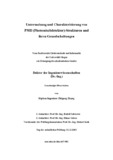Citation link:
https://nbn-resolving.org/urn:nbn:de:hbz:467-901| Dokument Type: | Doctoral Thesis | metadata.dc.title: | Untersuchung und Charakterisierung von PMD (Photomischdetektor)-Strukturen und ihren Grundschaltungen | Authors: | Zhang, Zhigang | Institute: | Fachbereich 12, Elektrotechnik und Informatik | Free keywords: | Photomischdetektor (PMD), optoelektronischer Prozessor (OEP), Mikrowellen-Mischdetektoren (MMD), photonic mixer device, optoelectronic processor, microwave mixer device | Dewey Decimal Classification: | 620 Ingenieurwissenschaften und Maschinenbau | GHBS-Clases: | WFFC | Issue Date: | 2003 | Publish Date: | 2006 | Abstract: | In den letzten 6 Jahren ist ein neuartiger optoelektronischer Detektor, der so genannte Photomischdetektor (PMD), an der Universität Siegen entwickelt worden. Er ermöglicht eine schnelle, hochgenaue Entfernungsmessung nach dem Laufzeitmessverfahren mit inkohärentem Licht und eröffnet damit neue Perspektiven zur 3D-Bilderfassung. In dieser Arbeit werden die charakteristischen Eigenschaften von verschiedenen halbleiter-basierten PMD-Strukturen und die weiteren technologischen Möglichkeiten zur Anwendung des PMDPrinzips untersucht. Der erste Teil dieser Arbeit befasst sich mit den physikalischen Grundlagen der Halbleiterphotodetektoren und der systematischen Beschreibung des Photogate (PG)-PMD. Das charakteristische Merkmal des PMD ist die inhärente Gegentaktmischung bzw. Korrelation, die unmittelbar im photosensitiven Bereich erfolgt. Eine wichtige Eigenschaft des Korrelationsempfangs ist die hohe Selektivität und Störunterdrückung. Mithilfe eines Funktionsmodells des Photogate-PMD werden die Modulations- und Korrelationseigenschaften der PMDs, besonders bei Kurzzeitintegration, analytisch und simulativ untersucht. Im zweiten Teil werden die vielfältigen Möglichkeiten zur Realisierung inhärent mischender Detektoren nach dem PMD-Prinzip dargestellt. Eine Variante der PMDs sind die selbstmodulierenden MSM-PMDs, welche neben dem Vorteil der GHz- Modulationsbandbreite die inhärente Eigenschaft der Hintergrundlichtunterdrückung besitzen. Eine Funktionalitätserweiterung der MSM-PMDs führt zum sog. Optoelektronischen Prozessor (OEP). Er ermöglicht eine schnelle analoge und digitale optoelektronische Signalverarbeitung. Andere halbleiter-basierte Ausführungsformen der PMDs werden kurz beschrieben. Auch die Erweiterung des PMD-Prinzips auf andere Technologiegebiete wie Mikrowellen- und Vakuumtechnik wird behandelt. Dabei werden einige Ausführungsbeispiele wie MMDs (Mikrowellen-Mischdetektoren), PMT-PMD (Photomultiplier-PMD), MCP-PMD (Microchannel Plate-PMD) und BV-PMD (Bildverstärker-PMD) vorgestellt. In the last 6 years, a novel optoelectronic detector called Photonic Mixer Device (PMD) has been developed at the University of Siegen, which opens up new perspectives for fast, highprecision non-contact range measurement and 3D-imaging using the time-of-flight (TOF) method. In this thesis the characteristic features of various semiconductor-based PMD structures and their modelling as well as further possibility of applying PMD-principle to other technologies are studied. The first part of this work deals with the systematic description and analysis of the photogate (PG-) PMD. A distinctive feature of the PMD compared to conventional photodetectors is its push-pull mixing process directly in the photosensitive region. A functional model of the PGPMD is developed enabling to simulate modulation and correlation properties, especially the behaviour of the suppression of non-correlated background illumination by short time integration. In the second part a variety of implementations of the PMD-concept is presented. One of the most important implementations is the MSM-PMD based on the metal-semiconductor-metal structure. It takes advantage of the very wide modulation bandwidth of MSM-detectors and possesses particularly the inherent ability to suppress the background illumination. The MSMPMD structure can be extended to a so-called “Optoelectronic Processor” (OEP), which is able to perform high speed optoelectronic analog and digital signal processing. Further semiconductor-based PMD realisation possibilities are also briefly discussed. Moreover, the PMD-principle is applicable to other detector technologies. Some possible implementations such as MMDs (Microwave Mixer Devices), PMT-PMD (Photomultiplier Tube PMD) and MCP-PMD (Microchannel Plate PMD) will be described. |
URN: | urn:nbn:de:hbz:467-901 | URI: | https://dspace.ub.uni-siegen.de/handle/ubsi/90 | License: | https://dspace.ub.uni-siegen.de/static/license.txt |
| Appears in Collections: | Hochschulschriften |
This item is protected by original copyright |
Page view(s)
536
checked on Nov 25, 2024
Download(s)
456
checked on Nov 25, 2024
Google ScholarTM
Check
Items in DSpace are protected by copyright, with all rights reserved, unless otherwise indicated.


